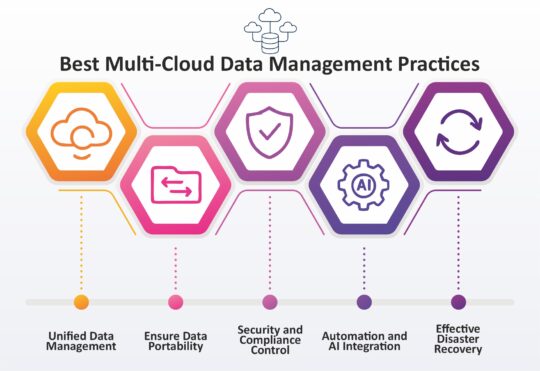In the midst of a digital transformation journey, companies are turning to cloud computing services to save the hassle of managing everything themselves. It enables them to concentrate on other important operations by streamlining tasks like database storage, facilitating easy sharing, and enhancing flexibility and accessibility, all of which lead to better collaboration.
In 2025, the cloud computing market has reportedly hit $912.77 billion, and it is projected to cross over $1 trillion by 2028. According to a survey of 750 IT professionals in 2023, 87% testified that their companies were embracing multi-cloud strategy. Companies have realized that relying on just one cloud computing service can really limit their freedom and flexibility. It creates a dependance on a single vendor, and if that cloud server gets overloaded or slows down, it can disrupt operations. This led companies to opt for multi-cloud data management.
What is Multi-cloud?
When a business seeks cloud computing services from multiple vendors at the same time to run digital operations rather than a single vendor. It enables a business to take advantage of multiple features offered by different cloud platforms.
Multi-cloud strategy also serves as a security measure by spreading the storage of crucial files across various clouds. If one cloud server experiences a cyberattack, the other servers can step in as backups, helping to safeguard data and maintain its integrity. Each cloud platform offers a range of services, and a multi-cloud strategy allows businesses the flexibility to utilize multiple features at the same time, depending on the workload.
Companies are adopting multi-cloud strategy for multiple benefits it offers. Let's look at a few benefits:
Perks of Multi-cloud Data Management-
Using multiple cloud platforms to meet your computing service needs comes with some benefits that can boost the productivity of a business.
- Flexibility: It allows a business to take advantage of the best features offered by various service providers, tailored to meet specific work requirements.
- Data Recovery: It enables you to distribute the original data and its copies across multiple platforms, making it easier to recover in case of data breach, deletion or theft.
- Minimize Dependency: It reduces the dependence on a single provider, ensuring that any outage or overload won’t disrupt operation and slow down productivity.
- Enhanced Performance: Multi-cloud data management optimizes the operations by utilizing the best of every platform.
- Avoid Downtime: If a business sets multiple clouds to operate parallelly, in case one cloud suffers any issue, the other can pick up and manage the workload preventing any downtime.
Let’s Compare: Multi-cloud VS Hybrid Cloud
It may become quite confusing for users to differentiate between the two major types of cloud strategies: Multi-cloud and Hybrid cloud. Let's dive deeper into the difference in both models:
| Features | Multi-cloud | Hybrid Cloud |
| Definition | Uses a variety of public cloud service providers. | Combines private cloud with public cloud services |
| Purpose | Avoid vendor lock in, select best services | Balance between privacy, security and scalability |
| Infrastructure | Integrate multiple cloud platforms (AWS + GCP) | Join private cloud + public cloud |
| Data Flow | Mostly independent in each cloud | Connected workload and seamless data |
| Example | A business using AWS and GCP for different features | A business using private cloud for transactions and public cloud customer engagement |
Best Multi-cloud Data Management Practices
Integrating multi-cloud strategy for data management might get tricky if you don’t have the right practices in place. Therefore, it is crucial to understand and implement the correct strategies to simplify the process.
1. Unified Data Management
It is the practice of applying a consistent set of rules, formats, processes and technologies to store and manage data across multiple cloud platforms as if they are a part of the same ecosystem.
The lack of unified data may lead to inconsistent data silos, violating privacy compliances, security concerns, and fragmented data.
Such issues can be avoided by unified data management through:
- Data cataloging
- Consistent formatting
- Authorized access and security compulsion
- Regulatory compliance
2. Ensure Data Portability
Data portability refers to the ability to easily share, transfer, or reuse data across different cloud servers without compromising its authenticity, accessibility, or context of the data. Organizations are turning to multi-cloud data management to boost flexibility, and data portability plays a significant role in effective management and utilization of data. Using multiple cloud platforms may lead to restricted data flow, hamper the quality of data and risk its availability.
These problems can be fixed through:
- Standardized data formats
- Cloud storage sync
- Compatible data encryption
- Data quality management
3. Security and Compliance Control
Distributing the database and workload of a business across multiple cloud platforms may enlarge the scope for cyberattacks and threats. That’s why it is necessary to adhere to all privacy regulations (GDPR, CCPA, ISO 27001, etc.) and control the security actions to avoid any data breaches, theft, legal matters and violation of regulatory compliance.
Such control can be ensured through:
- Identify and Data Management (IAM)
- Data encryption
- Network security
- Strict regulatory compliance
4. Automation and AI Integration
Automating repetitive and simple tasks can save the hassle of managing them manually and enables the system to perform them with minimum or no human intervention. Additionally, integrating artificial intelligence (AI) can upgrade the system to become self-sufficient to learn, grasp, adapt and predict allowing smarter functioning and multi-cloud data management. It improves accuracy and data handling through:
- Automate data formatting
- Data backup automation
- AI monitoring and alerts
- AI enabled risk forecast and rapid response
5. Effective Disaster Recovery
Disaster recovery, or DR, is one of the core elements of the BCP (business continuity plan) for any business to outline how a business would continue operations during and after disruption or downtime of any cloud platform. Businesses that run operations simultaneously on multiple cloud servers may suffer over workload in case of a server outage and not enough resources leading to downtime, data loss, and reduce efficiency which can be prevented through:
- Operate multiple clouds parallelly
- Sync cloud platforms
- Regular backup
- Effective failback mechanisms
The Future of Multi-cloud!
With business rapidly adopting multi-cloud data management strategies, the future holds a variety of technological revolutions like AI powered designs, cloud agnostics and focus on enhancing the security standards as the scope for threats keep expanding with rise in multi-cloud optimization.
To explore more tech driven solutions, subscribe to wisdomplexus.com
Explore More:
Risks Associated with Going Multi-cloud
Multi-Cloud Strategy Pros and Cons: You Should Be Aware Of





